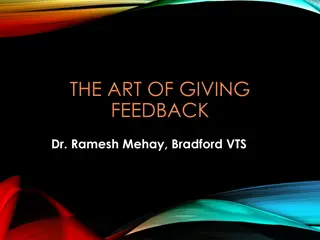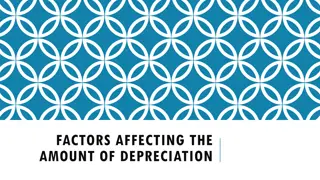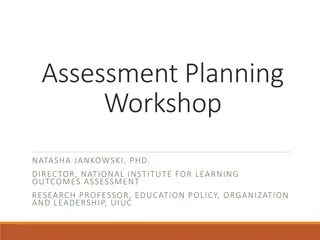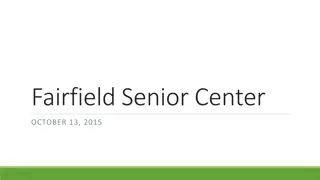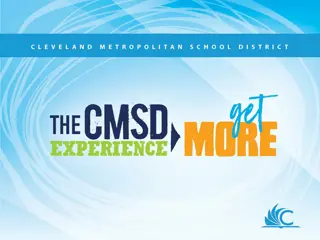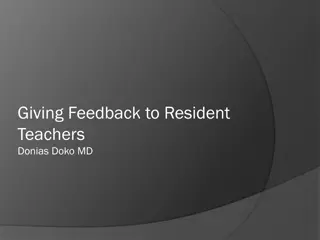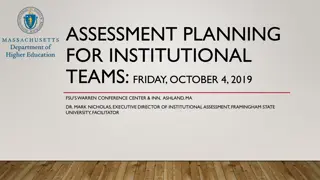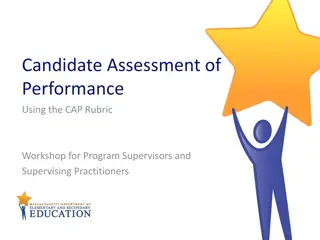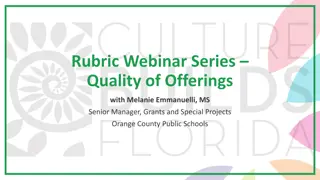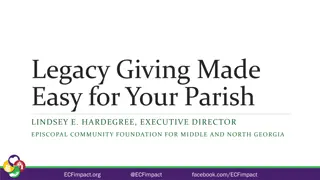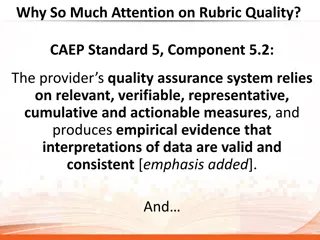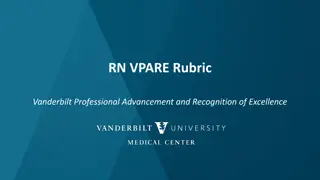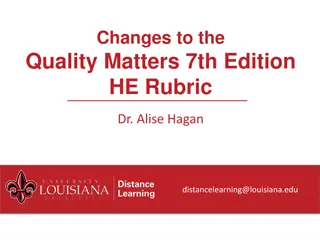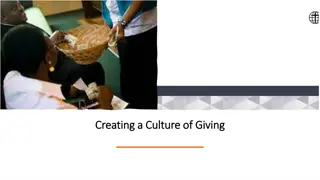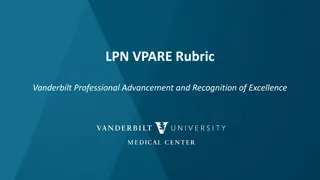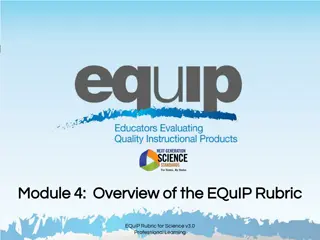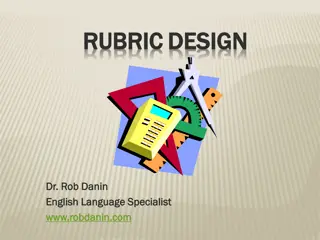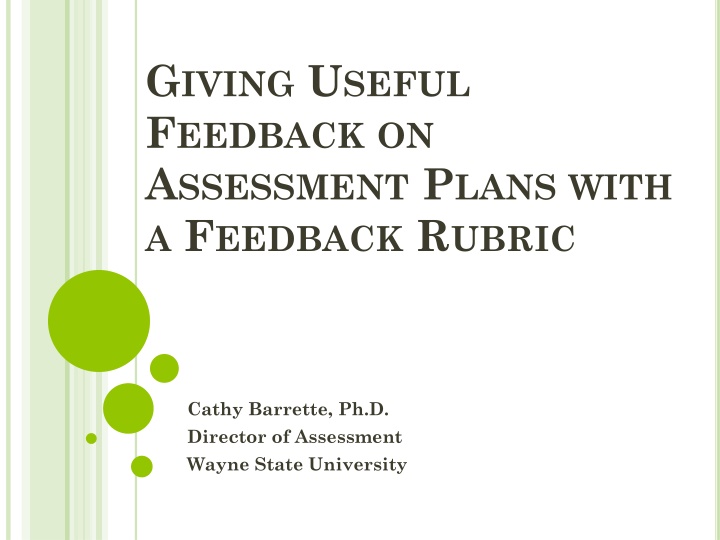
Effective Feedback Rubric for Assessment Plans
Enhance assessment plans with a feedback rubric to evaluate key elements such as mission statement, outcomes, and curriculum map. Obtain insights to improve program assessment strategies effectively.
Download Presentation

Please find below an Image/Link to download the presentation.
The content on the website is provided AS IS for your information and personal use only. It may not be sold, licensed, or shared on other websites without obtaining consent from the author. If you encounter any issues during the download, it is possible that the publisher has removed the file from their server.
You are allowed to download the files provided on this website for personal or commercial use, subject to the condition that they are used lawfully. All files are the property of their respective owners.
The content on the website is provided AS IS for your information and personal use only. It may not be sold, licensed, or shared on other websites without obtaining consent from the author.
E N D
Presentation Transcript
GIVING USEFUL FEEDBACK ON ASSESSMENT PLANS WITH A FEEDBACK RUBRIC Cathy Barrette, Ph.D. Director of Assessment Wayne State University
PRESENTATION OVERVIEW Definition and purpose of a feedback rubric Download the rubric: http://wayne.edu/assessment/files/wsu_program_asse ssment_plan_feedback_rubric_revised_20150203.docx Rubric organization Model of use Mission statement Outcomes Curriculum map Assessment method, results, action plan, and timeline Reporting
FEEDBACK RUBRIC: OVERVIEW An assessment plan feedback rubric is a tool for identifying the presence and quality of the pieces of a program s assessment plan individually (the mission statement, learning outcomes, curriculum map, and assessments) as well as together. In-person training is available; contact me to set a date. Goal: To easily provide programs with useful feedback about the strengths and weaknesses of their assessment plans that will enable them to improve their assessment plans.
PROGRAM NAME (e.g., MA in Language Learning): DATE: _________________ REVIEWED BY (individual or committee name):
RUBRIC ORGANIZATION MISSION STATEMENT Reflects best practices Meets standards Needs development Reviewer comments or suggestions The mission statement identifies: All points are included and are well developed. All points are included, but some need development. The statement might not be focused on students as the primary stakeholders. Few or none of the points are included. The program s (not the department s) purpose (i.e., why the program exists and what the program does that separates it from other units or programs). or The statement is too general to distinguish it from other programs or is focused on the department rather than the program. The program s key offerings (opportunities, experiences, areas of study that help program participants meet program goals).
At the end of the rubric are summary questions that require consideration of information across the pieces of the assessment plan.
MODEL OF THE RUBRIC PROCESS Examples used in the model are versions of an actual assessment plan that have been modified for the purposes of this presentation Instructions for using the rubric are included in the file you downloaded
INSTRUCTIONS FOR USING THE RUBRIC Write the name of the program, the date, and the name of the individual or committee reviewing the plan at the top of the rubric. Read the descriptions in the first column of each table plus the descriptions under the three rating categories (Reflects best practices, Meets standards, Needs development). As you read an assessment plan, check off the criteria that have been met in the first column Then check off the description(s) in the rating categories that best reflect the characteristics of the assessment plan. Write any feedback or suggestions you may have in the final column. Respond to the summary questions at the end of the form. Submit your rubric to your assessment coordinator, committee chair, or other appropriate designee. 1. 2. 3. 4. 5. 6. 7.
READ THE DESCRIPTIONS FIRST MISSION STATEMENT Reflects best practices Meets standards Needs development Reviewer comments or suggestions The mission statement identifies: All points are included and are well developed. All points are included, but some need development. The statement might not be focused on students as the primary stakeholders. Few or none of the points are included. . The program s (not the department s) purpose (i.e., why the program exists and what the program does that distinguishes it from other units or programs). or The statement is too general to distinguish it from other programs or is focused on the department rather than the program. The program s key offerings (opportunities, experiences, areas of study that help program participants meet program goals). The target audience or stakeholders (types of individuals or groups that would benefit from the program). or Most or all points are included, but are vague, unclear, or lack coherence. The wording of the statement is focused on students as the primary stakeholders and is clear to a general audience.
SAMPLE MISSION STATEMENT REVIEW The Master of Arts in Language Learning offers professional development in the theory, research, and practice of foreign language learning and teaching, advanced study of the foreign language and its cultures, and exposure to a complementary cognate area to enhance teachers professional knowledge and skills. The primary audience of the program is Metro Detroit foreign language teachers, many of whom are already certified foreign language teachers, who need and want continuing professional development. The mission statement identifies: The program s (not the department s) purpose The program s key offerings The target audience or stakeholders The wording of the statement is focused on students as the primary stakeholders and is clear to a general audience.
SAMPLE MISSION STATEMENT REVIEW The Master of Arts in Language Learning offers professional development in the theory, research, and practice of foreign language learning and teaching, advanced study of the foreign language and its cultures, and exposure to a complementary cognate area to enhance teachers professional knowledge and skills. The primary audience of the program is Metro Detroit foreign language teachers, many of whom are already certified foreign language teachers, who need and want continuing professional development. The mission statement identifies: The program s (not the department s) purpose The program s key offerings The target audience or stakeholders The wording of the statement is focused on students as the primary stakeholders and is clear to a general audience.
SAMPLE MISSION STATEMENT REVIEW The Master of Arts in Language Learning offers professional development in the theory, research, and practice of foreign language learning and teaching, advanced study of the foreign language and its cultures, and exposure to a complementary cognate area to enhance teachers professional knowledge and skills. The primary audience of the program is Metro Detroit foreign language teachers, many of whom are already certified foreign language teachers, who need and want continuing professional development. The mission statement identifies: The program s (not the department s) purpose The program s key offerings The target audience or stakeholders The wording of the statement is focused on students as the primary stakeholders and is clear to a general audience.
SAMPLE MISSION STATEMENT REVIEW The Master of Arts in Language Learning offers professional development in the theory, research, and practice of foreign language learning and teaching, advanced study of the foreign language and its cultures, and exposure to a complementary cognate area to enhance teachers professional knowledge and skills. The primary audience of the program is Metro Detroit foreign language teachers, many of whom are already certified foreign language teachers, who need and want continuing professional development. The mission statement identifies: The program s (not the department s) purpose The program s key offerings The target audience or stakeholders The wording of the statement is focused on students as the primary stakeholders and is clear to a general audience.
AFTERTHE FIRST COLUMNIS MARKED MISSION STATEMENT Reflects best practices Meets standards Needs development Reviewer comments or suggestions The mission statement identifies: All points are included and are well developed. All points are included, but some need development. The statement might not be focused on students as the primary stakeholders. Few or none of the points are included. None. The program s (not the department s) purpose (i.e., why the program exists and what the program does that separates it from other units or programs). or The statement is too general to distinguish it from other programs or is focused on the department rather than the program. The program s key offerings (opportunities, experiences, areas of study that help program participants meet program goals).
OUTCOMES SECTION Differentiates between program and learning outcomes Only student support services programs should focus on program outcomes Both academic and student support services programs should focus on learning outcomes Two descriptions in the first column apply only to program vs. learning outcomes, but all others apply to both: Program outcomes (for student services/ support programs ONLY): State a program performance goal Learning outcomes (academic and student services/support programs): State what graduating or exiting students should know, be able to do, believe, or value Both program and learning outcomes: Focus on the results of learning
REVIEWING OUTCOMES Read through all of the outcomes and consider them as a group Don t try to use the rubric for each outcome individually; you can use the comments box for more individual notes, as needed. Make check marks next to each description that is predominantly met Add comments or suggestions in the last column of the rubric for exceptions to the overall trend
SAMPLE LEARNING OUTCOMES REVIEW Students: study theory and research in second language acquisition and foreign language pedagogy. apply theory and research to the evaluation of pedagogical materials and activities. develop/create pedagogically sound materials. (pedagogically sound = student appropriately applies theory and research to the target teaching context) 1. 2. 3.
Reflects best practices Meets standards Needs development Reviewer comments OUTCOMES Program outcomes (for student services/ support programs ONLY): State a program performance goal (e.g., retention rates, service rates, satisfaction levels). If possible, these should be framed with a student focus. The 1st outcome needs to focus on the results of learning; the other 2 outcomes are fine. All outcomes meet all of the criteria. Most outcomes meet all of the criteria Few or none of the outcomes meet all of the criteria. Learning outcomes (academic and student services/support programs): State what graduating or exiting students should know, be able to do, believe, or value after participating in the program. and and or The assessment plan includes the required minimum number of outcomes. The assessment plan includes the required minimum number of outcomes. The assessment plan does not include the required minimum number of outcomes. Both program and learning outcomes: Focus on the results of learning or participating in the program, not on the learning process, program activities, or teaching. Isolate one behavior per outcome. (Exception: Outcomes required by disciplinary accrediting agencies.) Identify a measurable, observable behavior using an action verb(e.g., students summarize/compare/ design (observable) vs. understand/ know/are familiar with (not observable) or demonstrate (too vague)). Are clearly derived from the mission statement Are related or linked to at least one assessment. Are appropriate for the target audience (e.g., BA vs. MA students)
SAMPLE CURRICULUM MAP REVIEW Learning Outcome 6100 6120 6350 7XXX Electives LO 1 1 3 3 LO 2 1 LO 3 2 3 1 3 2 LO 4 2 LO 5 2 1 1 = a little, 2 = medium, 3= a lot, blank = not directly addressed
CURRICULUM MAP (optional for student services/support programs) The curriculum map: Reflects best practices Meets standards Needs development Reviewer comments or suggestions All information is provided in a clear format. All information is provided, but the format or content may not be clear. Only a subset of courses, activities, or milestones is provided. None. Lists each program learning outcome It is easy to determine how many opportunities students have to be introduced to, develop, and master their knowledge or skill with respect to each program learning outcome. Individually lists all courses and relevant, required activities, or milestones It takes some effort to determine how many opportunities students have to be introduced to, develop, and master their knowledge or skill with respect to each program learning outcome. or The relative attention given to each outcome in each course, activity, or milestone is not identified. Identifies the relative attention given to each outcome in each course, activity, or milestone ( Ideally, each program learning outcome is addressed in at least two courses, activities, or milestones.) Only includes information for one program
REVIEWING ASSESSMENTS Read through all of the assessments and consider them as a group Don t try to use the rubric for each assessment individually; you can use the comments box for more individual notes, as needed. Make check marks next to each description that is predominantly met Add comments or suggestions in the last column of the rubric for exceptions to the overall trend
DESCRIPTIONOF ASSESSMENTS Two assessments, one for the first learning outcome, which is actually Summarize (not Study ) theory and research in FL teaching and learning , the second assessment is for Develop/Create pedagogically sound materials Participants and scoring process are the same, the grading rubric is the same Research papers vs. Pedagogical projects as data sources Only some sections of the rubric are used for data for each outcome (highlighted in blue)
SAMPLE ASSESSMENT 1 (FORSUMMARIZE) Data source: Students research papers in the Methodology Core (LGL) courses, plus Master s essays for graduating students. Papers will be scored by MALL faculty using the shared MALL essay grading rubric, which includes subscores for the following elements: 1. review of literature (accurate, relevant, critical, logical argumentation) 2. critical thinking Data: Scores for each relevant subsection of the grading rubric Analysis: MALL faculty will conduct an annual review of students performance on research papers and essay for these sections of the grading rubric. The criterion level for successful achievement is an 85% average score across all papers.
SAMPLE ASSESSMENT 2 (FORCREATE) Data source: Students pedagogical projects in the Methodology Core (LGL) courses, plus Master s essays for graduating students. Papers will be scored by MALL faculty using the shared MALL essay grading rubric, which includes subscores for the following elements: 1. design of pedagogical materials 2. critical thinking Data: Scores for each relevant subsection of the grading rubric Analysis: MALL faculty will conduct an annual review of students performance on pedagogical projects for these sections of the grading rubric. The criterion level for successful achievement is an 85% average score across all projects.
Reflects best practices Meets standards Needs development Reviewer comments or suggestions ASSESSMENT METHOD The assessment method describes, in detail: what the data source is (scores from exams, surveys, presentations, etc.) how the data will be gathered and by whom how often/when the data will be gathered who will evaluate/score it what the evaluation scale is (%? SD SA? 0-5? P/F?) the criteria for acceptable performance (e.g., 85% pass rate, 75% score, 80% agree or strongly agree) who will review the results and when they will be reviewed It s unclear whether the data will be useful or whether it s practical to gather. One category of the rubric is used for two outcomes, so it doesn t completely isolate data. All information is provided. All information is provided, but some details need clarification. Not all information is provided. or Many details need clarification. or The assessment does not provide useful data about the target learning outcome. (e.g., retention rates (as data) don t reveal whether students write well (where writing well is the target learning outcome)) or The assessment does not isolate data about the target learning outcome from other information. (In most cases, course grades as a data source fall under this category.) or The assessment is not practical. The method includes sufficient detail to easily understand whether the assessment is appropriate for measuring the target learning outcome(s). The assessment isolates useful data about the target learning outcome from other information. The assessment isolatesuseful data* about the target learning outcome from other information. *Useful data means that your scores, responses, results, etc. are at an appropriate level of detail to provide information about just one learning outcome and provide an indication about what the program should retain or change. The assessment isolatesuseful data* about the target learning outcome from other information. The assessment is practical. The assessment is practical. The assessment method is practical (i.e., it can be implemented with existing time and resources).
SAMPLE RESULTS For Fall 2014, scores on students summaries of theory and research averaged 99%. This average exceeded the target 85% average for this learning outcome. Data file attached.
RESULTS Reflects best practices Meets standards Needs development Reviewer comments or suggestions The results should include: All information is provided and is clear. All information is provided, but some details need clarification. Not all information is provided. None. A summary of the scores, responses, or other data, including any problems that arose. ( Results for the current year are linked to previous years results, as applicable.) or The information provided is unclear. A statement of whether the results met, failed to meet, or exceeded the target or criterion level of performance. or The data do not support the summary. A data file (student-level scores, responses, etc.; omit identifiers)
SAMPLE ACTION PLAN Results from the AY13-14 assessment of LO 1.0 revealed that the grading rubrics used to assess student performance provided ambiguous information. They inadvertently combined into a single score students' ability to objectively report the contents of published research with their ability to evaluate the validity of that research. As a result, we have taken two steps: Redefinition of our original learning outcomes: We have redefined LO 1.0 from "Analysis of theory and research" to "Summarize theory and research" to focus on students' ability to objectively report the contents of published research. We have redefined LO 2.0 to focus on the use of theory and research to effectively evaluate pedagogical materials and activities. The revised outcomes are already entered in Compliance Assist. 1. Revision of our grading rubrics: We have drafted a modified grading rubric for the MA essay, and during AY 14-15 we will revise the comparable sections of each assignment's grading rubric to match this new focus. 2. These changes will enable us to gather information that clearly separates information about one skill (summarizing objectively) from another skill (evaluating the information). As such, we will again gather data on this learning outcome for AY 14-15.
ACTION PLAN Reflects best practices Meets standards Needs development Reviewer comments or suggestions An action plan: Identifies at least one area of the program or of the assessment plan that will be monitored, remediated, or enhanced. States at least one logical step the program will take in response to item a to improve the program. Identifies a person or group responsible for carrying out the next step. All information is provided. All information is provided, but some details need clarification. Little or no information is provided or it is unclear. or The chosen action(s) do not clearly or logically relate to the Results section. or Actions focus on students behavior rather than on program changes. Define we to identify who will carry out the action plan. The chosen action(s)* clearly and logically relate to the Results section. The chosen action(s) clearly and logically relate to the Results section. *Actions for outcomes that were not met might include changes to the program s curriculum, teaching methodology, assessment tools, etc. Continued monitoring or substitution with a new outcome are examples of actions for outcomes that were met.
SAMPLE TIMELINEFORTHE ACTION PLAN MALL faculty will complete the revision of the grading rubrics by December 2014. Data for this assessment will be gathered again in December 2014 and April 2015 and analyzed by May 15, 2015. TIME LINE FOR THE ACTION PLAN Reflects best practices Meets standards Needs development Reviewer comments or suggestions The time line sets a schedule for implementing the action plan. All parts of the action plan have specific deadlines for implementation and completion. Most parts of the action plan have specific deadlines for implementation and completion. Few or none of the parts of the action plan have specific deadlines for implementation and completion.
SAMPLE REPORT Results are not reported to stakeholders at present. However, the MALL faculty will need to meet this academic year to make a plan for disseminating this information to stakeholders. Our tentative plan is to present the results on the program's website. A draft of the report is attached. REPORTING Reflects best practices Meets standards Needs development Reviewer comments or suggestions All information is provided. All information is provided. Little or no information is provided. or The information provided is unclear. or The information will not be effectively shared with stakeholders in a timely manner. Reporting includes the program s plan for where/how to communicate the process, results, and action plan (e.g., program website, scholarly publication, newsletter) to whom the report should be communicated when the reporting will be completed. The information will be appropriately shared with stakeholders in a timely manner. The information will be appropriately shared with stakeholders in a timely manner. More than one venue for dissemination is planned.
SAMPLE SUMMARY QUESTIONS Does the assessment plan make use of at least one direct measure per program learning outcome (whenever possible)? YES 1. Does the assessment plan include multiple measures for each program learning outcomes? NO 2. Do any of the assessments measure learning or development over time (e.g., following a cohort of students from program entry to exit)? NO 3.
SAMPLE SUMMARY QUESTIONS 4. Which phrase best characterizes the overall quality of this assessment plan? The plan a. reflects best practices b. meets standards c. needs development Notes: Mission statement: Reflects best practices Outcomes: Meets standards Curriculum map: Needs development Assessment method: Needs development Results: Reflects best practices Action plan: Meets standards Timeline: Reflects best practices Reporting: Needs development
YOUR TURN Try your hand at providing feedback on one of the assessment plans from your department.
CONTACT INFORMATION Dr. Cathy Barrette, WSU Director of Assessment c.barrette@wayne.edu (313)577-1615 4092 Faculty/Administration Building (Provost s suite)
PRODUCTION CREDITS Thank you to Wayne State University s Foreign Language Technology Center! http://www.langlab.wayne.edu/index.htm

